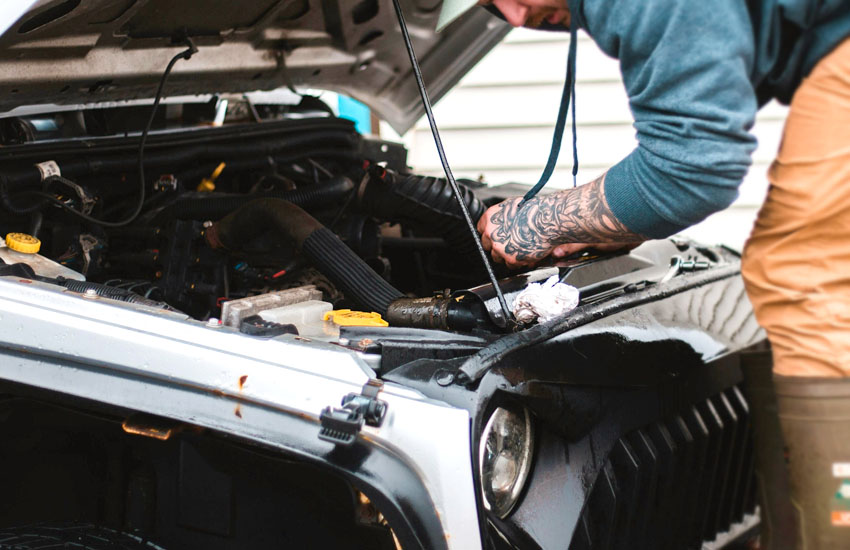As an Amazon Associate, I earn from qualifying purchases at no extra cost to you.
What Should I Do If I Find Water on the Oil Dipstick?
You pull out your oil dipstick, expecting clean, smooth oil—but wait… there's water in it? That's never a good sign. Water in your engine oil can mean trouble, but don't panic just yet! It could be something minor, or it could be a bigger issue that needs quick attention. Either way, ignoring it isn't an option. So, what should you do next? Let's break it down step by step and figure out the best fix for your engine!

Why is There Water on My Oil Dipstick?
When you see water on your oil dipstick, the first thing that might come to mind is a serious engine problem. While it can be a sign of an issue, it doesn't always mean you need to rush to a mechanic. Water on the dipstick could be caused by a variety of reasons, ranging from a minor issue to something more serious. Understanding why it happens is key to fixing the problem effectively.
1. Condensation Build-Up
One of the most common reasons for water to appear on the oil dipstick is condensation. This happens when your car’s engine cools down after being used, especially in cold weather. If your car has been running for short trips or has been sitting idle for a while, moisture can build up in the engine. This moisture then combines with the oil and ends up on the dipstick when you check it.
Condensation isn't a huge problem in itself, but it can cause damage over time if it's not dealt with. The water can mix with the oil, affecting the oil’s ability to lubricate the engine properly. If you live in an area with cold winters or often drive short distances, this could be the culprit. In these cases, simply driving your car for a longer period on the highway might help evaporate the moisture and resolve the issue.
2. A Blown Head Gasket
A blown head gasket is one of the more serious causes of water in the oil. The head gasket sits between the engine block and cylinder head, sealing in coolant and oil while preventing leaks between the two. If the head gasket blows, coolant can leak into the oil system, which will show up as water on the oil dipstick. This is a serious problem because it can lead to engine overheating, poor performance, and severe engine damage if left untreated.
In this case, you may notice other symptoms like the engine running hot, white smoke from the exhaust, or the oil appearing milky and frothy. If you suspect a blown head gasket, it’s essential to get your car inspected by a professional mechanic immediately. Replacing a head gasket is a complicated and expensive repair that requires expertise.
3. Cracked Engine Block or Cylinder Head
A cracked engine block or cylinder head can also allow water or coolant to mix with oil, leading to water on the dipstick. Cracks can occur due to engine overheating, age, or manufacturing defects. If you find water on your oil dipstick and the engine is also showing signs of overheating or poor performance, it's crucial to take your car to the shop. A cracked engine block or cylinder head is a major problem that could lead to costly repairs or even the need for a full engine replacement.
4. Faulty Oil Cooler
An oil cooler is designed to regulate the temperature of the engine oil to prevent it from overheating. However, if the oil cooler develops a crack or leaks, coolant or water can mix with the oil. This can show up as water on the oil dipstick. Like the blown head gasket, a faulty oil cooler is a significant issue that requires immediate attention. Depending on the severity of the damage, an oil cooler repair or replacement may be necessary.
5. Incorrect Oil Change Practices
Sometimes, water on the oil dipstick can be caused by improper oil change practices. If the oil wasn't drained properly, or if new oil mixed with old oil, moisture could remain in the system. This might show up as water on the dipstick, especially if the engine wasn't run for long enough to allow all the contaminants to be flushed out. This issue can typically be fixed by performing another oil change, ensuring that the system is fully drained and flushed.
How To Fix Water in the Oil
Now that we know what might cause water to show up on the oil dipstick, let's go through the steps on how to fix it. The first step is determining the cause of the issue, which can help you decide whether it's something you can handle yourself or if you need a mechanic's help. Here's how you can proceed:
1. Perform a Basic Inspection
Before diving into any major repairs, it's important to inspect the situation and see what you're dealing with. Start by checking the oil itself. If the oil appears milky or frothy, it's a strong indication that water has mixed with the oil. This is typically caused by a blown head gasket or coolant leak, so keep an eye out for these symptoms. Additionally, check for signs of coolant leaks under the vehicle, in the engine bay, or around the oil filter.
2. Drive the Car for a Longer Distance
If you suspect the water is due to condensation (especially in colder climates), a simple fix might be driving your car for a longer period. Take the car on a highway or at higher speeds for at least 20-30 minutes. This will allow the engine to reach its optimal operating temperature, which can help burn off any moisture. After the drive, check the oil dipstick again to see if the water has dissipated.
If you notice that the problem persists after a long drive, it's likely something more serious, and further investigation will be needed.
3. Flush the Engine Oil System
If there's a lot of water in the oil or if the oil looks frothy and milky, it's time to drain the oil and replace it with fresh oil. This will help remove any contaminants and water from the system. Start by draining the oil using the oil pan and then replace the oil filter. Once the oil is drained, flush the system by running the engine for a short period without oil. This helps remove any remaining water.
Afterward, install a new filter, add fresh oil, and check the dipstick again to see if the water has been removed. This can solve the issue if it's just a minor build-up of condensation or old oil mixing with moisture.
4. Check and Replace the Head Gasket
If flushing the system doesn't solve the issue, it could be due to a blown head gasket. Unfortunately, replacing a head gasket is a major repair job that should be done by a professional mechanic. If you're comfortable working on engines, you can attempt it yourself, but it's a complex job that involves removing the cylinder head and the gasket, replacing it, and then reassembling everything. If you're unsure, take your car to a trusted mechanic who can properly diagnose and replace the gasket.
5. Inspect and Replace the Oil Cooler
If the oil cooler is the culprit, it needs to be replaced. Start by locating the oil cooler, which is usually near the oil filter or the engine block. If you notice coolant leaking from the oil cooler or it appears damaged, you'll need to remove and replace it. Replacing an oil cooler is a labor-intensive job that requires draining the oil, removing hoses, and carefully installing the new cooler. It's best left to a mechanic unless you're experienced with car repairs.
6. Fixing Cracked Engine Blocks or Cylinder Heads
If you suspect that the engine block or cylinder head is cracked, the situation becomes much more serious. Cracked engine blocks or cylinder heads require expensive and intricate repairs. In some cases, the engine block might need to be replaced entirely. If you notice any signs of engine block cracks, such as coolant leakage, poor engine performance, or excessive overheating, it's time to take the car to a certified mechanic for a thorough inspection and repair.
I hope this article helped you understand what to do if you find water on your oil dipstick. It's not always as scary as it sounds, but it's important to address it early to avoid costly engine damage. Whether the issue is minor condensation or a major engine problem, following these steps can help you find a solution. Don't hesitate to consult a professional if needed, but with the right approach, you can keep your engine running smoothly for years to come!
Frequently Asked Questions
Is it normal to find water on the oil dipstick?
No, it is not normal. Water on the dipstick typically indicates a problem, such as condensation or a blown head gasket.
Can water on the dipstick cause engine damage?
Yes, if left unaddressed, water can mix with oil and damage engine parts, leading to poor lubrication and potentially severe engine issues.
Do I need to replace the oil if I find water on the dipstick?
Yes, if the oil is contaminated with water, it's important to flush the system and replace the oil to ensure proper engine lubrication.
Can I fix a blown head gasket myself?
Fixing a blown head gasket is a complex job that usually requires professional help, as it involves disassembling the engine to replace the gasket.
Is it possible for a faulty oil cooler to cause water on the dipstick?
Yes, a faulty oil cooler can cause coolant or water to mix with the oil, which could show up as water on the dipstick.
Can short trips cause water to form on the oil dipstick?
Yes, short trips can cause condensation to form inside the engine, leading to moisture mixing with the oil. A longer drive may help resolve this.
Is water on the oil dipstick a sign of engine failure?
Not necessarily, but if the problem is related to something like a blown head gasket or cracked engine parts, it could lead to more serious issues.
Can I drive my car with water on the oil dipstick?
If you see water on the dipstick, it's best to address the issue as soon as possible. Driving with contaminated oil can lead to engine damage.











